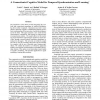Free Online Productivity Tools
i2Speak
i2Symbol
i2OCR
iTex2Img
iWeb2Print
iWeb2Shot
i2Type
iPdf2Split
iPdf2Merge
i2Bopomofo
i2Arabic
i2Style
i2Image
i2PDF
iLatex2Rtf
Sci2ools
AAAI
2007
2007
A Connectionist Cognitive Model for Temporal Synchronisation and Learning
The importance of the efforts towards integrating the symbolic and connectionist paradigms of artificial intelligence has been widely recognised. Integration may lead to more effective and richer cognitive computational models, and to a better understanding of the processes of artificial intelligence across the field. This paper presents a new model for the representation, computation, and learning of temporal logic in connectionist systems. The model allows for the encoding of past and future temporal logic operators in neural networks, through a neural-symbolic translation algorithms introduced in the paper. The networks are relatively simple and can be used for reasoning about time and for learning by examples with the use of standard neural learning algorithms. We validate the model in a well-known application dealing with temporal synchronisation in distributed knowledge systems. This opens several interesting research paths in cognitive modelling, with potential application...
| Added | 02 Oct 2010 |
| Updated | 02 Oct 2010 |
| Type | Conference |
| Year | 2007 |
| Where | AAAI |
| Authors | Luís C. Lamb, Rafael V. Borges, Artur S. d'Avila Garcez |
Comments (0)

